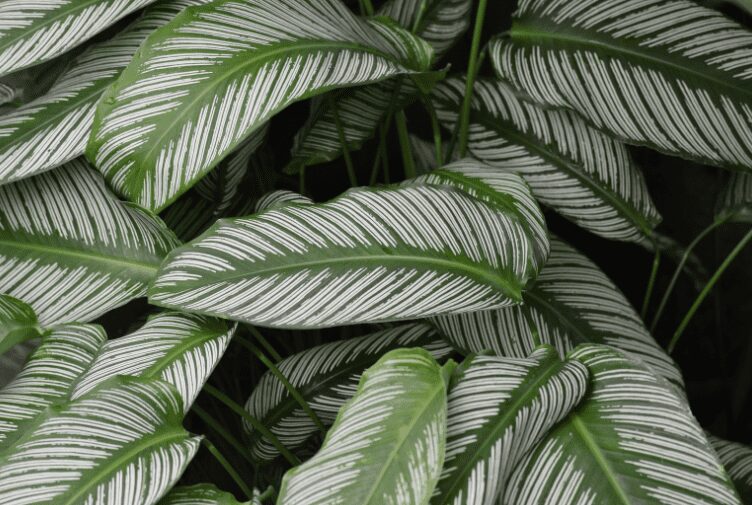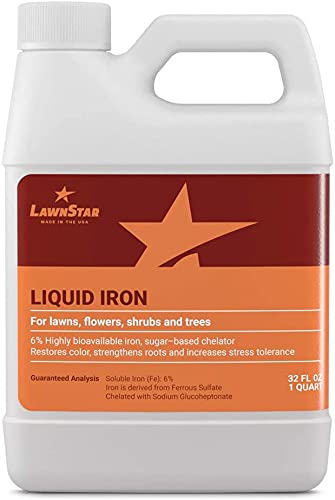
Calathea ‘White Fusion’ cultivar has variegated foliage with green leaves and white markings. The stems have a magenta hue on the underside.
Once you get their care right, you’ll be rewarded with an eye-catching display of foliage that grows profusely and rapidly.
Plant Features
Plants are compact and quickly produce side shoots. The new variety is commercially suitable for four-inch, six-inch, and eight-inch pot production.
The new variety is Calathea, typically produced as an indoor ornamental plant.”
The bold markings on the foliage of Calathea make them trendy tropical houseplants. As a result of their decorative leaves resembling characteristics of those animals, they are also called peacock plants, zebra plants, or rattlesnake plants.
The inflorescences of Calathea species are known for their striking shapes in their native habitats, but they rarely flower indoors.
White markings contrast with green leaves on the variegated foliage of the calathea ‘White Fusion’ cultivar. The stems have a magenta hue on the underside.
Although their care can be a little more particular than some houseplants, once you get it right, you’ll be rewarded with a garland of foliage that grows profusely and rapidly.
Calathea Care
‘White Fusion’ is no exception to the specific care requirements of calatheas.
Moisture is good for these plants, but not excessive amounts, sun exposure is good but not overly hot, and extreme temperatures should be prevented.
Calathea ‘White Fusion’ large leaves should be cleaned regularly to remove dust. Plants breathe better when the dust is removed from their leaves.
You should not use any leaf shine products; they can cause damage to your leaves. When you see an infrequent, small amount of discoloration, don’t panic. It is usual for this cultivar to have brown tips; the foliage is delicate.
Temperature and Humidity
Temperature extremes should be avoided. Sweltering heat can be too much for this plant despite liking warmer temperatures.
During the winter, if you heat your home all day and then turn it off at night, your plant could be shocked.
Heating units and their drying conditions can also decimate humidity levels.
The plant pot can be placed on top of a tray filled with pebbles if retaining humidity is a concern.
In the long run, any water that drains out and collects in the pebbles will evaporate and increase humidity levels without soaking the roots.
As an alternative, you can purchase a humidifier that benefits tropical houseplants. Make sure your calathea ‘White Fusion’ is not exposed to direct drafts, but keep it adequately ventilated.
Pruning
Cut off browned or curled leaves from your calathea White Fusion if they are excessively brown or curled.
Remove any dead, dying, or damaged leaves from the soil as soon as you notice them.
In healthy plants, new leaves grow and fill in for dead ones as long as they are given the care and conditions they need. Deadhead faded blooms.
Fertilizer
Liquid fertilizer should be applied monthly during Calathea ‘White Fusion’ growth period — spring through fall. Stop feeding during the winter.
You should use a nitrogen-rich fertilizer designed for houseplants with dense foliage. Using half the strength of fertilizer recommended on the fertilizer container will only be necessary.
How to Grow Calathea ‘White Fusion’ From Seed
The best way to start calathea seeds is to moisten them and plant them in well-draining potting soil. The seed should be planted about 1/4 inch deep.
Keep the soil warm by covering the container with plastic wrap. Germination can be sped up with the help of a heating pad if the soil needs to be warmed.
Make sure the pot is placed in a bright but indirect light source. Sprouting can take up to a month.
As soon as a seedling grows at least an inch tall, carefully lift it while keeping the root structure intact. Plant the seeds in a larger container, at least 2 inches in diameter.
During The Winter
There is no way a calathea plant can survive a freezing winter or a frost.
During the cooler months, prepare to bring your plant indoors to a bright spot with the indirect sun by introducing the plant to indoor life slowly – two hours a day at first, then increasing by an hour each day.
Avoid drafts and heaters when growing plants. Ensure that the humidity around the plant is high and mist it if necessary.
When the outdoor climate warms again, gradually reintroduce the plant to outdoor life by bringing it out for two hours a day, then increasing it by an hour each day.
This plant is sensitive to temperature changes and may drop a few leaves if the temperature changes drastically.
Calathea ‘White Fusion’ Potting and Repotting
The soil should be replenished once a year (or every two years). Infected Calathea plants can die from fungal infections if they become rootbound.
Every time you make a container, increase its size by one or two inches. Terra-cotta pots allow water to evaporate through their walls if you tend to overwater your plants.
Investing in glazed clay, plastic, or fiberglass pots might be a good idea if you tend to forget to water your plants. During the active growing season, repot your plant in spring or early summer.
Plants will be less stressed if they are thoroughly watered a day or two before replanting.
How to Bloom Calathea ‘White Fusion’
When it reaches maturity, Calathea ‘White Fusion’ produces small flowers.
Calathea rarely blooms when grown indoors. Keeping their ideal conditions indoors will let you know that you have discovered the secret to their success in growing.
However, the flowers are not attractive and don’t smell.
The most common problem with Calathea’s’ White Fusion.’
Plants of all types of Calathea require moderate maintenance. Humidity, temperature, drafts, water level, and lighting are all important. An out-of-balance plant is prone to growth problems or health problems.
Browning Leaves
Overwatering causes calathea white fusion leaves to turn yellow, brown, or die.
You should remove dead calathea white fusion leaves as soon as possible to prevent the plant from rotting, smelling bad, and inviting fungi.
When exposed to direct sunlight or too close to a window, calathea ‘White Fusion’ leaves turn brown and can droop or fall off.
Protect the delicate leaves of the plant by moving it away from the window.
Wilting Or Drooping Leaves
Whenever calatheas need more water, the leaves will wilt, curl, or droop downward.
Water frequency or volume should be increased. You can mist its leaves or invest in a small humidifier to give the plant more moisture.
Patterns On Leaves Are Disappearing.
This plant will produce more chlorophyll when overexposed to the sun, making the leaves greener.
You can fix this problem by finding a spot with filtered or dappled light.
Plant Diseases and Pests
Occasionally, fungus gnats can be a problem with calathea ‘White Fusion’ due to their preference for high humidity environments.
Despite their unsightliness and unpleasantness, they won’t do much damage. Natural deterrents include neem oil applied to the leaves.
Aphids, mealybugs, spider mites, and scale are also common pests. Each can be treated using horticultural oil or insecticidal soap.
Calathea plants are prone to bacterial and fungal infections when overwatered despite their need for high humidity.
It is necessary to destroy your plant if it develops a Pseudomonas leaf spot (white splotches on the leaves) since there is no treatment for this bacterial infection.
Water the soil only (not the leaves) or from underneath to reduce the risk of spreading this disease.
Several root rot symptoms include yellowing leaves, stunted growth, and rotting at the plant’s base.
To treat root rot, remove the plant from the pot and inspect the roots below the soil line.
Rotten roots must be treated immediately if they are brown. There is nothing wrong with yellow roots. Cut off brown or mushy roots with sterile pruning snips or a knife.
In warm soapy water, wash the pot. You should replace the soil with fresh, well-draining soil. Plant the fresh soil where the root was cut and treat it with an antifungal.
Ensure the soil in the container is loose so the roots can breathe.
FAQ
-
What is the best place to put calathea in my house?
Calatheas dislike direct sunlight. South-facing spots with intense direct sunlight should be avoided. The best windows are usually those facing east, west, or north.
It is also possible to diffuse bright light with sheer curtains. Plant grow lights are also beneficial to these plants.
-
Alternatives to Calathea ‘White Fusion’?
Calathea and Stromanthe sanguine are closely related plants. It is also called ‘Triostar’ or ‘Tricolor.’ As opposed to ‘White Fusion’s pinkish leaves, this plant has reddish leaves along with white and green. The crocodile fern also has patterned, ornate foliage.
Crocodile scales are reflected in their foliage. As with calathea, this type of fern prefers moderate to high humidity, but it’s more forgiving if conditions aren’t ideal.
-
Calathea and maranta differ in what ways?
Often called prayer plants, calathea and maranta are members of the Marantaceae family.
The maranta, however, is considered a “true prayer plant.” due to its leaf movement at various times of the day.
In the evening, prayer plant leaves form a vertical “praying hand” position.
Depending on the amount of light in their environment, liquid moves in special cells at the base of each leaf.
Plant Heritage
United States Patent for calathea plant named `fusion white` has been issued to Yam Taiyan. Yam Taiyan developed this invention.
The patent application number is 13/987,702. The International Patent Classification code is A01H 5/00 (20060101).
The abstract released by U.S. Patent and Trademark Office states, “A new and distinct Calathea cultivar named `FUSION WHITE` is disclosed, characterized by showy green, light green and white patchy and marbled variegation.
Last update on 2024-11-21 / Affiliate links / Images from Amazon Product Advertising API






























